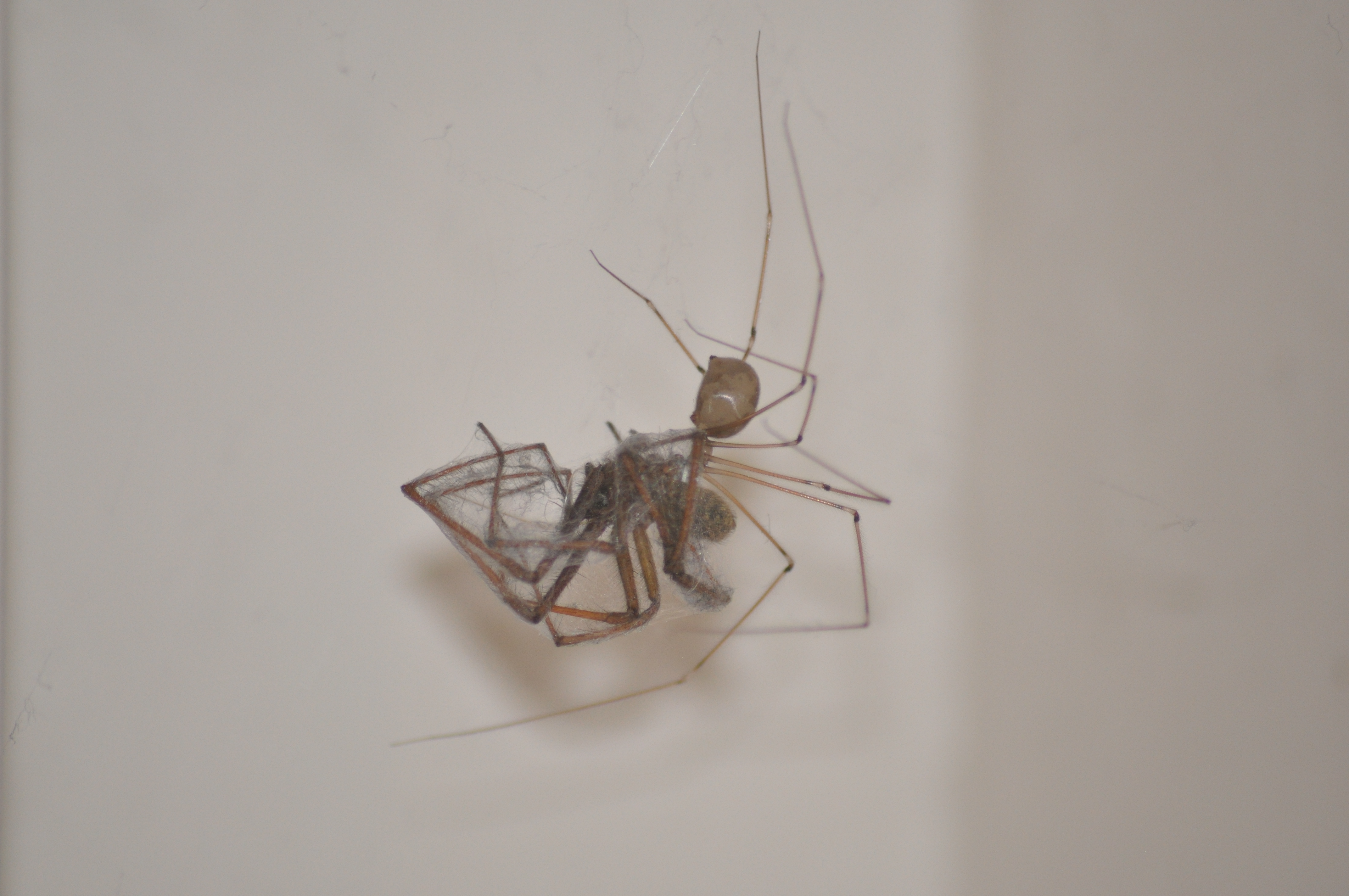|
Smeringopus Pallidus
''Smeringopus pallidus'', known as the pale daddy-long-leg, is a species of spider of the genus '' Smeringopus'', family Pholcidae. It is a cosmopolitan species found in many countries. Description This species has a body length up to 7 mm, with males being smaller than females. It has a cylindrical and elongate abdomen. The purple spots along the dorsal surface of the abdomen are a characteristic feature. There is a dark stripe on the ventral surface of the sternum. A synanthropic spider, it builds irregular cobwebs in sheltered areas to capture small insects and other spiders for food. The legs lack spines and have a few vertical hairs. The female has a simple epigynum without pockets. Habitat ''Smeringopus pallidus'' can be found in dusty and dark corners of the house. They also build their webs under covered drains and on mud walls in gardens and the countryside. When disturbed, they hang upside down in the web and vibrate themselves vigorously to confuse the intruder ... [...More Info...] [...Related Items...] OR: [Wikipedia] [Google] [Baidu] |
Spider
Spiders ( order Araneae) are air-breathing arthropods that have eight legs, chelicerae with fangs generally able to inject venom, and spinnerets that extrude silk. They are the largest order of arachnids and rank seventh in total species diversity among all orders of organisms. Spiders are found worldwide on every continent except for Antarctica, and have become established in nearly every land habitat. , 50,356 spider species in 132 families have been recorded by taxonomists. However, there has been debate among scientists about how families should be classified, with over 20 different classifications proposed since 1900. Anatomically, spiders (as with all arachnids) differ from other arthropods in that the usual body segments are fused into two tagmata, the cephalothorax or prosoma, and the opisthosoma, or abdomen, and joined by a small, cylindrical pedicel, however, as there is currently neither paleontological nor embryological evidence that spiders ever had ... [...More Info...] [...Related Items...] OR: [Wikipedia] [Google] [Baidu] |
Smeringopus
''Smeringopus'' is a genus of cellar spiders that was first described by Eugène Louis Simon in 1890. Species it contains fifty-five species, found in Africa, South America, Asia, Australia, and on the Pacific Islands: *'' S. affinitatus'' Strand, 1906 – Ethiopia *'' S. arambourgi'' Fage, 1936 – Ethiopia, Somalia *'' S. atomarius'' Simon, 1910 – Namibia, Botswana, South Africa *'' S. badplaas'' Huber, 2012 – South Africa *'' S. blyde'' Huber, 2012 – South Africa *'' S. bujongolo'' Huber, 2012 – Congo, Uganda *'' S. butare'' Huber, 2012 – Congo, Rwanda, Burundi *'' S. bwindi'' Huber, 2012 – Congo, Uganda *'' S. carli'' Lessert, 1915 – Uganda, Tanzania, Comoros, Madagascar *'' S. chibububo'' Huber, 2012 – Mozambique *'' S. chogoria'' Huber, 2012 – Kenya *'' S. cylindrogaster'' (Simon, 1907) – West, Central Africa *'' S. dehoop'' Huber, 2012 – South Africa *'' S. dundo'' Huber, 2012 – Congo, Angola *'' S. florisbad'' Huber, 2012 – South Africa *'' S. ... [...More Info...] [...Related Items...] OR: [Wikipedia] [Google] [Baidu] |
Pholcidae
The Pholcidae are a family of araneomorph spiders. The family contains over 1,800 individual species of pholcids, including those commonly known as cellar spider, daddy long-legs spider, carpenter spider, daddy long-legger, vibrating spider, gyrating spider, long daddy, and skull spider. The family, first described by Carl Ludwig Koch in 1850, is divided into 94 genera. The common name "daddy long-legs" is used for several species, especially ''Pholcus phalangioides'', but is also the common name for several other arthropod groups, including harvestmen and crane flies. Appearance Pholcids are thin and delicate arachnids. The body, resembling the shape of a peanut, is approximately 2–10 mm (0.08–0.39 inch) in length, and the legs may be up to 50 mm (1.97 inches) long. ''Pholcus'' and ''Smeringopus'' have cylindrical abdomens and eyes arranged in two lateral groups of three and two smaller median contiguous eyes. Arrangements of eight and six ey ... [...More Info...] [...Related Items...] OR: [Wikipedia] [Google] [Baidu] |
Glossary Of Spider Terms
This glossary describes the terms used in formal descriptions of spiders; where applicable these terms are used in describing other arachnids. Links within the glossary are shown . Terms A Abdomen or opisthosoma: One of the two main body parts ( tagmata), located towards the posterior end; see also Abdomen § Other animals Accessory claw: Modified at the tip of the in web-building spiders; used with to grip strands of the web Anal tubercle: A small protuberance (tubercule) above the through which the anus opens Apodeme → Apophysis (plural apophyses): An outgrowth or process changing the general shape of a body part, particularly the appendages; often used in describing the male → Atrium (plural atria): An internal chamber at the entrance to the in female haplogyne spiders B Bidentate: Having two Book lungs: Respiratory organs on the ventral side (underside) of the , in front of the , opening through narrow slits; see also Book lungs Branchial operculum � ... [...More Info...] [...Related Items...] OR: [Wikipedia] [Google] [Baidu] |
Synanthropic
A synanthrope (from the Greek σύν ''syn'', "together with" + ἄνθρωπος ''anthropos'', "man") is a member of a species of wild animal or plant that lives near, and benefits from, an association with human beings and the somewhat artificial habitats that people create around themselves (see anthropophilia). Such habitats include houses, gardens, farms, roadsides and rubbish dumps. The category of synanthrope includes many species regarded as pests or weeds. It does not, however, include domesticated animals such as cattle, honeybees, pets, poultry, silkworms, and working animals. Examples of synanthropes are various insect species (lice, ants, silverfish, cockroaches, etc.), house sparrows, rock doves (pigeons), crows, various rodent species, Virginia opossums, raccoons, certain monkey species, coyotes, deer, urban ferals, passerines, and other urban wildlife. Plants include Pineapple Weed, Dandelion, Chicory, and Plantain. The brown rat is counted as one of the most ... [...More Info...] [...Related Items...] OR: [Wikipedia] [Google] [Baidu] |
Pale Daddy-long-leg(Smeringopus Pallidus)
Pale may refer to: Jurisdictions * Medieval areas of English conquest: ** Pale of Calais, in France (1360–1558) ** The Pale, or the English Pale, in Ireland *Pale of Settlement, area of permitted Jewish settlement, western Russian Empire (1791–1917) Geography Africa * Palé, town in Guinea Asia * Burma ** Pale, Myanmar, town ** Pale Township *India ** Pale, Dahanu, village ** Pale, Goa, census town Europe * Pale (Greece), ancient town in Kefalonia, today part of Lixouri, Greece * Pale, Bosnia and Herzegovina, a town and municipality * Palé, Hungary, a village * Pāle parish, Latvia * Pale River, Estonia * Pale-Prača, Bosnia and Herzegovina, a municipality Arts, entertainment, and media Music * ''Pale'' (album), a 1990 release of Toad the Wet Sprocket * Pale (band), an Australian band formed in 1991 * The Pale (band), an Irish band formed in 1990 * The Pale, renamed The Pale Pacific, an American indie rock band * ''The Pale'' (EP), by William Control * "Pale", a tr ... [...More Info...] [...Related Items...] OR: [Wikipedia] [Google] [Baidu] |
List Of Pholcidae Species
This page lists all described genera and species of the spider family Pholcidae. , the World Spider Catalog accepts 1820 species in 94 genera: A ''Aetana'' ''Aetana'' Huber, 2005 * '' Aetana abadae'' Huber, 2015 — Philippines * '' Aetana baganihan'' Huber, 2015 — Philippines * '' Aetana banahaw'' Huber, 2015 — Philippines * '' Aetana fiji'' Huber, 2005 — Fiji * '' Aetana gaya'' Huber, 2015 — Malaysia (Gaya Is.) * '' Aetana indah'' Huber, 2015 — Borneo * '' Aetana kinabalu'' Huber, 2005 — Borneo * '' Aetana kiukoki'' Huber, 2015 — Philippines * '' Aetana lambir'' Huber, 2015 — Borneo * '' Aetana libjo'' Huber, 2015 — Philippines * ''Aetana loboc'' Huber, 2015 — Philippines * '' Aetana lozadae'' Huber, 2015 — Philippines * '' Aetana manansalai'' Huber, 2015 — Philippines * '' Aetana mokwam'' Huber, 2019 — Indonesia (West Papua) * '' Aetana ocampoi'' Huber, 2015 — Philippines * '' Aetana omayan'' Huber, 2005 ( type) — Philippines * ''Aetana ondawamei' ... [...More Info...] [...Related Items...] OR: [Wikipedia] [Google] [Baidu] |
Spiders Described In 1858
Spiders (order Araneae) are air-breathing arthropods that have eight legs, chelicerae with fangs generally able to inject venom, and spinnerets that extrude silk. They are the largest order of arachnids and rank seventh in total species diversity among all orders of organisms. Spiders are found worldwide on every continent except for Antarctica, and have become established in nearly every land habitat. , 50,356 spider species in 132 families have been recorded by taxonomists. However, there has been debate among scientists about how families should be classified, with over 20 different classifications proposed since 1900. Anatomically, spiders (as with all arachnids) differ from other arthropods in that the usual body segments are fused into two tagmata, the cephalothorax or prosoma, and the opisthosoma, or abdomen, and joined by a small, cylindrical pedicel, however, as there is currently neither paleontological nor embryological evidence that spiders ever had a separate th ... [...More Info...] [...Related Items...] OR: [Wikipedia] [Google] [Baidu] |



